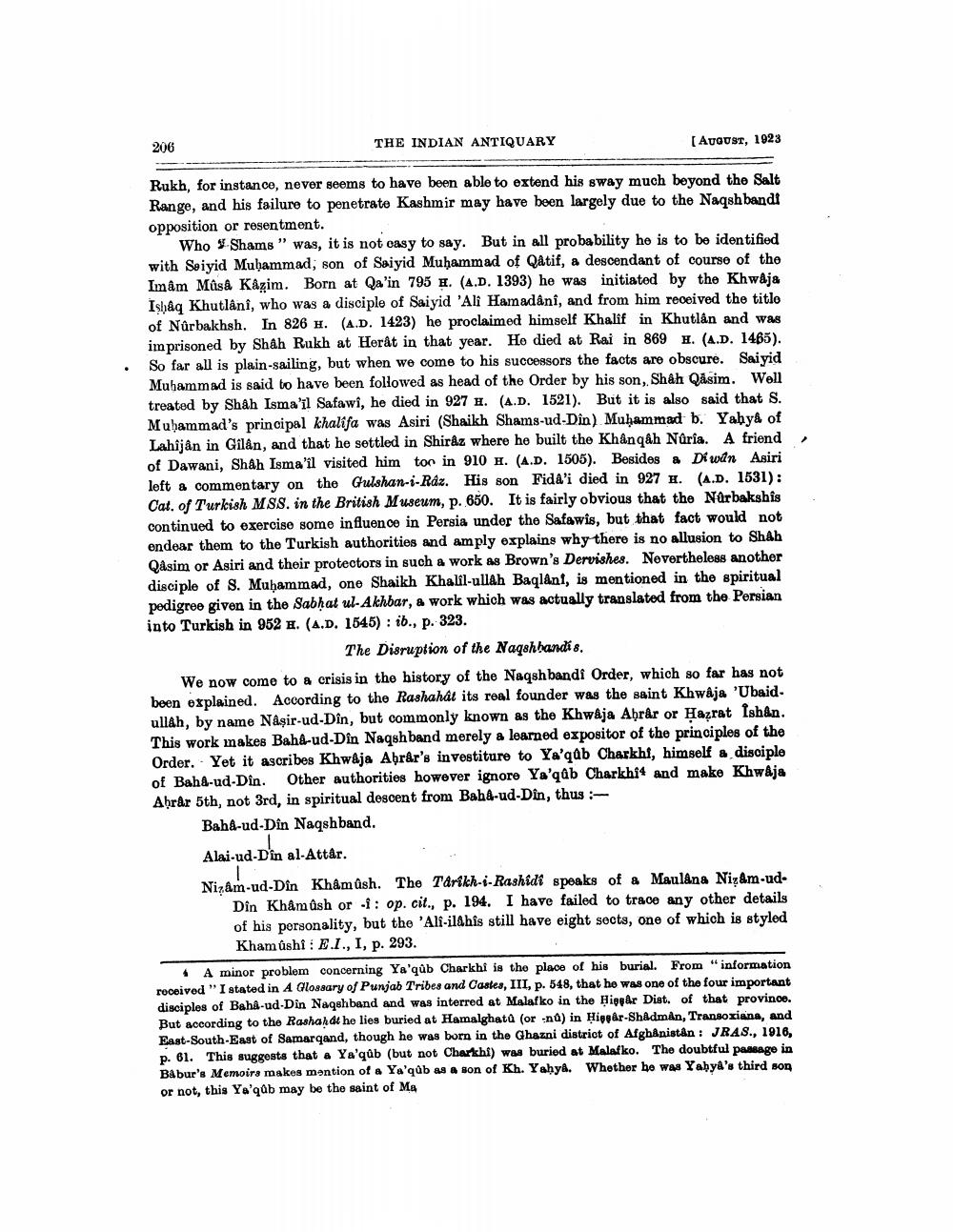________________
206
THE INDIAN ANTIQUARY
(August, 1923
Rukh, for instance, never seems to have been able to extend his sway much beyond the Salt Range, and his failure to penetrate Kashmir may have been largely due to the Naqshbandi opposition or resentment.
Who Shams" was, it is not oasy to say. But in all probability he is to be identified with Seiyid Muhammad, son of Saiyid Muhammad of Qatif, a descendant of course of the Imâm Mâsâ Kâzim. Born at Qa'in 795 1. (A.D. 1393) he was initiated by the Khwaja Ishaq Khutlânî, who was a disciple of Saiyid 'Ali Hamadani, and from him received the title of Nürbakhsh. In 826 H. (A.D. 1423) he proclaimed himself Khalif in Khutlån and was imprisoned by Shah Rukh at Herät in that year. He died at Rai in 869 1. (A.D. 1465). So far all is plain-sailing, but when we come to his successors the facts are obscure. Saiyid Muhammad is said to have been followed as head of the Order by his son, Shah Qasim. Well treated by Shah Isma'il Safawi, he died in 927 H. (A.D. 1521). But it is also said that S. Muhammad's principal khalifa was Asiri (Shaikh Shams-ud-Din) Muhammad b. Yahyâ of Lahijan in Gilân, and that he settled in Shiraz where he built the Khânqah Núria. A friend of Dawani, Shah Isma'il visited him ton in 910 1. (A.D. 1505). Besides a Diwan Asiri left a commentary on the Gulshan-s-Raz. His son Fida'i died in 927 H. (A.D. 1531): Cat. of Turkish MSS. in the British Museum, p. 650. It is fairly obvious that the Norbakshis continued to exercise some influence in Persia under the Safawis, but that fact would not ondear them to the Turkish authorities and amply explains why there is no allusion to Shah Qasim or Asiri and their protectors in such a work as Brown's Dervishes. Novertheless another disciple of S. Muhammad, one Shaikh Khalil-ullah Baqlant, is mentioned in the spiritual pedigree given in the Sabhat ul-Akhbar, a work which was actually translatod from the Persian into Turkish in 952 1. (A.D. 1545): ib., p. 323.
The Disruption of the Naqshbandis, We now come to a crisis in the history of the Naqshbandi Order, which so far has not been explained. According to the Rashahat its real founder was the saint Khwaja 'Ubaid. ullah, by name Naşir-ud-Din, but commonly known as the Khwaja Ahrar or Hazrat Ishan. This work makes Bahd-ud-Din Naqshband merely a learned expositor of the principles of the Order.. Yet it ascribes Khwaja Abrar's investiture to Ya'qub Charkhi, himself a disciple of Baha-ud-Din. Other authorities however ignore Ya'qub Charkhi4 and make Khwaja Abrar 5th, not 3rd, in spiritual descent from Baha-ud-Din, thus
Baha-ud-Din Naqshband. Alai-ud-D'in al-Attar.
Nizam-ud-Din Khâm ush. The Tarikh-i-Rashidi speaks of a Maulana Nizam-ud
Din Khâm âsh or ? : op. cit., p. 194. I have failed to trace any other details of his personality, but the 'Ali-il&his still have eight sects, one of which is styled
Kham ůshi : E.I., I, p. 293. 4 A minor problem concerning Ya'qub Charkhi is the place of his burial. From "information received "I stated in A Glossary of Punjab Tribes and Castea, III, p. 548, that he was one of the four important disciples of Baha-ud-Din Naqshband and was interred at Malafko in the Hippar Dist. of that province. But according to the Rashandt he lies buried at Hamalghata (or -nů) in Hippar-Shadman, Transoxiana, and East-South East of Samarqand, though he was born in the Ghazni district of Afghanistan: JRAS., 1916. p. 61. This suggests that a Ya'qub (but not Charkhi) was buried at Malafko. The doubtful passage in Babur's Memoirs makes mention of a Ya'qub as a son of Kh. Yahya. Whether he was Yahya's third son or not, this Ya'qub may be the saint of Me




